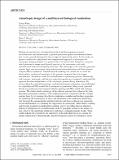| dc.contributor.author | Wang, Lifeng | |
| dc.contributor.author | Song, Juha | |
| dc.contributor.author | Ortiz, Christine | |
| dc.contributor.author | Boyce, Mary Cunningham | |
| dc.date.accessioned | 2012-03-28T16:30:54Z | |
| dc.date.available | 2012-03-28T16:30:54Z | |
| dc.date.issued | 2009-12 | |
| dc.date.submitted | 2009-05 | |
| dc.identifier.issn | 0884-2914 | |
| dc.identifier.issn | 2044-5326 | |
| dc.identifier.uri | http://hdl.handle.net/1721.1/69879 | |
| dc.description.abstract | Biological materials have developed hierarchical and heterogeneous material microstructures and nanostructures to provide protection against environmental threats that, in turn, provide bioinspired clues to improve human body armor. In this study, we present a multiscale experimental and computational approach to investigate the anisotropic design principles of a ganoid scale of an ancient fish, Polypterus senegalus, which possesses a unique quad-layered structure at the micrometer scale with nanostructured material constituting each layer. The anisotropy of the outermost prismatic ganoine layer was investigated using instrumented nanoindentations and finite element analysis (FEA) simulations. Nanomechanical modeling was carried out to reveal the elastic-plastic mechanical anisotropy of the ganoine composite due to its unique nanostructure. Simulation results for nanoindentation representing ganoine alternatively with isotropic, anisotropic, and discrete material properties are compared to understand the apparent direction-independence of the anisotropic ganoine during indentation. By incorporating the estimated anisotropic mechanical properties of ganoine, microindentation on a quad-layered FEA model that is analogous to penetration biting events (potential threat) was performed and compared with the quad-layered FEA model with isotropic ganoine. The elastic-plastic anisotropy of the outmost ganoine layer enhances the load-dependent penetration resistance of the multilayered armor compared with the isotropic ganoine layer by (i) retaining the effective indentation modulus and hardness properties, (ii) enhancing the transmission of stress and dissipation to the underlying dentin layer, (iii) lowering the ganoine/dentin interfacial stresses and hence reducing any propensity toward delamination, (iv) retaining the suppression of catastrophic radial surface cracking, and favoring localized circumferential cracking, and (v) providing discrete structural pathways (interprism) for circumferential cracks to propagate normal to the surface for easy arrest by the underlying dentin layer and hence containing damage locally. These results indicate the potential to use anisotropy of the individual layers as a means for design optimization of hierarchically structured material systems for dissipative armor. | en_US |
| dc.description.sponsorship | National Science Foundation (U.S.) (MIT Center for Materials Science and Engineering (DMR-0819762)) | en_US |
| dc.description.sponsorship | Massachusetts Institute of Technology. Institute for Soldier Nanotechnologies (DAAD-19-02-D-0002) | en_US |
| dc.description.sponsorship | United States. Dept. of Defense (National Security Science and Engineering Faculty Fellowship) | en_US |
| dc.language.iso | en_US | |
| dc.publisher | Cambridge University Press/Materials Research Society | en_US |
| dc.relation.isversionof | http://dx.doi.org/10.1557/jmr.2009.0443 | en_US |
| dc.rights | Article is made available in accordance with the publisher's policy and may be subject to US copyright law. Please refer to the publisher's site for terms of use. | en_US |
| dc.source | Prof. Ortiz via Angie Locknar | en_US |
| dc.title | Anisotropic design of a multilayered biological exoskeleton | en_US |
| dc.type | Article | en_US |
| dc.identifier.citation | Wang, Lifeng et al. “Anisotropic Design of a Multilayered Biological Exoskeleton.” Journal of Materials Research 24.12 (2009): 3477–3494.© Cambridge University Press 2009. | en_US |
| dc.contributor.department | Massachusetts Institute of Technology. Department of Materials Science and Engineering | en_US |
| dc.contributor.department | Massachusetts Institute of Technology. Department of Mechanical Engineering | en_US |
| dc.contributor.approver | Ortiz, Christine | |
| dc.contributor.mitauthor | Boyce, Mary Cunningham | |
| dc.contributor.mitauthor | Wang, Lifeng | |
| dc.contributor.mitauthor | Song, Juha | |
| dc.contributor.mitauthor | Ortiz, Christine | |
| dc.relation.journal | Journal of Materials Research | en_US |
| dc.eprint.version | Final published version | en_US |
| dc.type.uri | http://purl.org/eprint/type/JournalArticle | en_US |
| eprint.status | http://purl.org/eprint/status/PeerReviewed | en_US |
| dspace.orderedauthors | Wang, Lifeng; Song, Juha; Ortiz, Christine; Boyce, Mary C. | en |
| dc.identifier.orcid | https://orcid.org/0000-0003-3511-5679 | |
| dc.identifier.orcid | https://orcid.org/0000-0002-2193-377X | |
| mit.license | PUBLISHER_POLICY | en_US |
| mit.metadata.status | Complete | |
